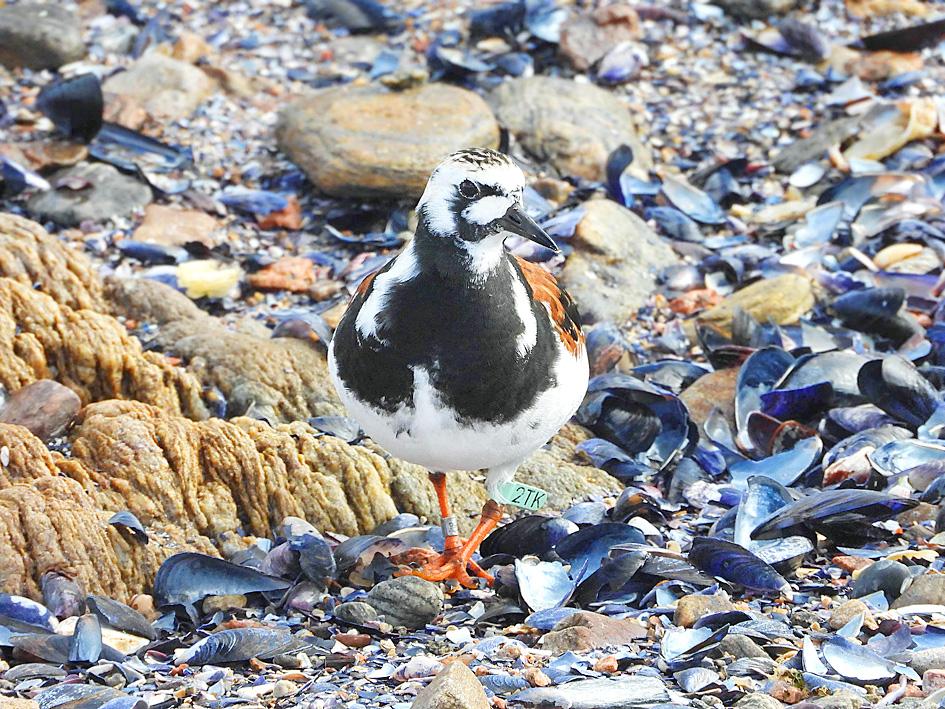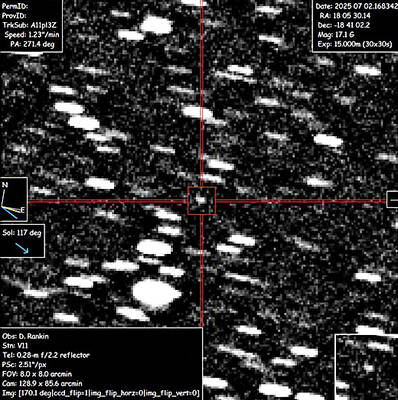The first cold winds announce the arrival of winter in Uruguay’s jet setters’ playground, Punta del Este.
It is time for “2TK” to set flight from the plush seaside resort and return to Canada, a feat of endurance that fascinates scientists and delights local birdwatchers.
Identifiable by a plastic band on one ankle bearing the name 2TK and a metal one with nine digits on the other, this ruddy turnstone (Arenaria interpres) has spent the southern hemisphere summer on the rocks off Uruguay’s Atlantic coast feeding off mussels, alongside oystercatchers and other birds.

Photo: AFP / Birdwatching Punta El Este / Alvaro Perez
When the food became scarce in Canada’s artic tundra as winter swept in, the turnstone migrated 15,000km to South America.
By last month, 2TK had become “fatter” and ditched his gray plumage for one tinged with brown and orange ahead of his return to his native lands to reproduce, said Alvaro Perez Tort, 48, an amateur photographer and member of the Punta del Este birdwatching society that has been documenting the bird’s trips to Uruguay since 2016.
“2TK stole my heart,” he said.
Every year he waits for the male turnstone’s return to document him “as much as possible” to share on reportband.gov — the continental database for observing banded birds run by the US Geological Survey.
“What’s interesting is that a banded bird has a history: There’s a city, a country or faraway place, a journey and people,” Perez said.
By photographing the bird “we feel like we’re a part” of that history, he said, adding that he has seen 2TK eight times at Uruguay’s southernmost tip.
2TK is about 14 years old, said the Bird Banding Laboratory, which organizes the banding of 1 million birds annually in North America for conservation purposes.
He was banded in 2012 in Delaware Bay on the US Atlantic coast, an important stopover for many migratory species.
For laboratory head Antonio Celis-Murillo, information provided by amateur birdwatchers is vital to “build the jigsaw puzzle” of each bird’s movements.
“Our work is successful thanks to the general public — every person who reports a banded bird,” he said. “The reported information is so simple but valuable, because scientifically it tells us a lot.
“Especially those reports from South America that we lack,” he added.
These details allow scientists to plot the behavior of every species: their migration routes, where they stop, how long they stay there, how they live. It all helps to refine conservation projects.
According to a 2019 study published in the Science magazine, about 3,000 species of wild birds have disappeared from North America since 1970.
Loss of habitat affecting all biodiversity “clearly shows its impact on migratory birds,” who face ever-greater difficulties in their extraordinary journeys, said Adrian Azpiroz, a biologist and ornithologist who promotes ecotourism initiatives.
While turnstones are not threatened like other waders, their population is nonetheless shrinking.
Of the estimated 300,000 on the continent, only several hundred or thousand winter on the Uruguayan coast. Others prefer southern Brazil or Argentina.
Scientists believe these long-distance migratory birds have favorite winter retreats and are remarkably loyal, returning year after year — just like 2TK.
Uruguay’s many coastal lagunas are “very productive from a nourishment point of view” for waders, Azpiroz said.
That is why 2TK is likely to have traveled about 350,000km in his life — the equivalent of nine times around the planet.
That is a truly staggering accomplishment for a bird measuring little more than 20cm.
Experts are still studying the sophisticated physiological and neurological mechanisms that allow him to recognize a location with such precision following a weeks-long air journey of thousands of kilometers.
Many Uruguayan birdwatchers like to think the same thing that attracts them to return time and again to Punta del Este is what also caught 2TK’s attention.

Two former Chilean ministers are among four candidates competing this weekend for the presidential nomination of the left ahead of November elections dominated by rising levels of violent crime. More than 15 million voters are eligible to choose today between former minister of labor Jeannette Jara, former minister of the interior Carolina Toha and two members of parliament, Gonzalo Winter and Jaime Mulet, to represent the left against a resurgent right. The primary is open to members of the parties within Chilean President Gabriel Boric’s ruling left-wing coalition and other voters who are not affiliated with specific parties. A recent poll by the

Irish-language rap group Kneecap on Saturday gave an impassioned performance for tens of thousands of fans at the Glastonbury Festival despite criticism by British politicians and a terror charge for one of the trio. Liam Og O hAnnaidh, who performs under the stage name Mo Chara, has been charged under the UK’s Terrorism Act with supporting a proscribed organization for allegedly waving a Hezbollah flag at a concert in London in November last year. The rapper, who was charged under the anglicized version of his name, Liam O’Hanna, is on unconditional bail before a further court hearing in August. “Glastonbury,

TENSIONS HIGH: For more than half a year, students have organized protests around the country, while the Serbian presaident said they are part of a foreign plot About 140,000 protesters rallied in Belgrade, the largest turnout over the past few months, as student-led demonstrations mount pressure on the populist government to call early elections. The rally was one of the largest in more than half a year student-led actions, which began in November last year after the roof of a train station collapsed in the northern city of Novi Sad, killing 16 people — a tragedy widely blamed on entrenched corruption. On Saturday, a sea of protesters filled Belgrade’s largest square and poured into several surrounding streets. The independent protest monitor Archive of Public Gatherings estimated the

FLYBY: The object, appears to be traveling more than 60 kilometers per second, meaning it is not bound by the sun’s orbit, astronomers studying 3I/Atlas said Astronomers on Wednesday confirmed the discovery of an interstellar object racing through the solar system — only the third-ever spotted, although scientists suspect many more might slip past unnoticed. The visitor from the stars, designated 3I/Atlas, is likely the largest yet detected, and has been classified as a comet, or cosmic snowball. “It looks kind of fuzzy,” said Peter Veres, an astronomer with the International Astronomical Union’s Minor Planet Center, which was responsible for the official confirmation. “It seems that there is some gas around it, and I think one or two telescopes reported a very short tail.” Originally known as A11pl3Z before